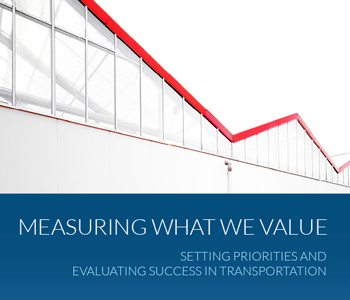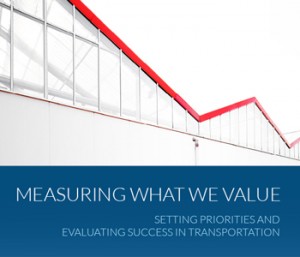
Don’t settle for the limited things Congress could agree on: Performance measures for members, part II

If states and metro areas don’t act now to establish their own priorities for their transportation system, they’ll end up only measuring what Congress deemed important in MAP-21. The time is now to start the conversation of what else also matters to the leaders and citizens in your area.
This is the second post in a series on performance measures by Beth Osborne, T4America Senior Policy Advisor. Read the rest of the series and dive into a high-level overview of the concept, learn more about choosing the best measures for addressing your priorities, and learn how to demonstrate to the public that their dollars are being used wisely. -Ed.
With federal performance measures rolling out, what happens next?

Beth Osborne, T4America
The transition to a new system of “performance measurement” represents an attempt by Congress to get a better sense of how our transportation system is performing nationally, to allow states and regions to be compared with against another, and to communicate with the public about what they are getting for their tax dollars.
With USDOT nearing the end of the rulemaking process for establishing new performance measures for our transportation dollars, attention will turn to state DOTs and MPOs which will soon need to establish accompanying goals for their transportation system in these limited priority areas set by Congress, including safety, infrastructure condition, air pollution and congestion.
Each state DOT and MPO will set a target for each of USDOT’s measures. For example, State A may currently have 700 highway fatalities a year and want to bring this down to 650. The state would announce that goal, describe which projects will help them attain it and then report back to USDOT and the public about whether they hit their target.
In the case of the safety and infrastructure conditions measures, if a state or MPO fails to hit their target then they’ll have to spend a minimum amount of funding in that area. In the case of the other measures, there is no specific implication or consequence if targets are missed. But the process should still help improve accountability and transparency for priorities and spending: the public will have the chance to help set those targets, scrutinize whether or not the projects being chosen are likely to help meet the state and/or regional goals and to hold leadership responsible for the results.
Should we do more? Why won’t these federal measures alone be enough for our state or MPO?
If you have other important priorities and big picture goals for your transportation dollars outside of the limited set of measures agreed to by Congress — and many of you do — you need to begin work now to establish your own system. If not, with all the time and attention going into Congress’ limited measures, they could easily overwhelm your other priorities not addressed by them.
If your other priorities are to get the same emphasis, they need to receive the same treatment, including a system for measuring and setting goals for those priorities. Failing to have your other measures in place could easily lead to a system where projects get funded to satisfy federal measures but neglect certain regional priorities or even do damage to them. For example, building a highway expansion to address auto congestion (federal measure) that cuts off local access to jobs in a commercial center (metro priority).
One example of how to ensure your priorities are in the mix
The Salt Lake City region has conducted extensive outreach to the public and stakeholders to identify goals for the region with excellent results. Through a (widely admired and emulated) visioning process called “Envision Utah” that engaged thousands of citizens in its feedback process, the booming Salt Lake City region looked at future challenges and considered different ways to grow, including the infrastructure needs associated with each vision. They developed several approaches and evaluated them against their valued priority outcomes, like protection of open space, household transportation cost, and disaster resilience — all measures that the federal performance measure system will not take into account.
By doing this a decade ago, the region chose a growth pattern that saved $4.5 billion in avoided infrastructure costs over 10 years. And the public involvement led to strong support and excitement for the eventual projects selected based on this process. Citizens see their views reflected in the vision, and feel included in the process — which, incidentally, makes it easier to raise new revenue to invest in transportation, as the state recently did.
Transportation is just a mechanism to reach your shared vision and goals, so focus on the goals first
What is particularly exciting about Utah’s approach is that it isn’t rooted in the notion that transportation is a separate thing; an end unto itself. Their analysis of transportation needs flow from the shared vision for the region overall and aren’t simply reactive to current traffic conditions. The region believes that transportation should be planned to support economic development in the area and that traffic flow alone does not equal economic development.
Remember almost no one travels just to travel. There’s always a destination in mind. The goal is to get to work in order to earn money or to get to school to pick up your kids or to get to the doctor for medical care. The end goal isn’t just to drive the designed speed of the roadway or never spend a minute in congestion, though that is often where traditional engineering standards can take you. On the other hand, it is not the job of the engineers to decide our values or choose the community’s broader goals and outcomes. That is the job of the political and civic leadership.
And performance measures are where that process happens.
Now is the time to start the conversations with stakeholders and the public to ensure all regional priorities are being considered and measures are chosen to address those goal areas. And if you want your regional and local priorities to be reflected in the state DOT’s performance management system, a discussion about how to align those priorities should occur before the federal rules are pushing states to implement the new system.
For more information, feel free to check out our report on performance measures, Measuring What We Value.




